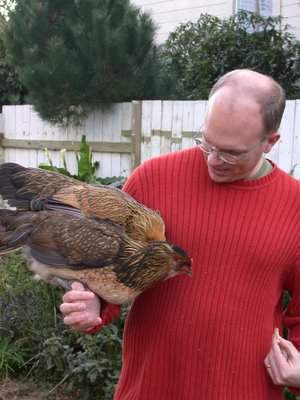Dolley's developed this monster crop lately (for you non-poultry types, the crop is an organ just under the skin on the chicken's chest where food goes for the first stage of digestion), and we're not sure if it's impacted or what. It's sort of soft and squishy, but always big--larger than a golf ball, smaller than a tennis ball. She's also making this swallowing move like she's trying to get something down.
She could have eaten some long strands of grass that she can't digest. She could have eaten some string or whatever other odd thing a chicken might turn up in the garden--a bit of plastic, a rubber band, who knows. It's possible that she's got a little infection. We've been watching her for a week and it hasn't gotten better or worse, but it seems like we should take some action.
First step was to remove their food when they went to bed tonight. That way, we can check her in the morning when the crop should, in theory, be empty. That'll give us an idea of what might be stuck in there.
Actually, I take that back. The first step was to try to smell her breath. This is tricky--it's not easy to get a hen to open her beak for you, much less to get your nose in there before she snaps it shut again. The idea is that if she has a sour crop (old, nasty food stuck in the crop that she can't digest because of a blockage), we'd be able to smell it.
To tell you the truth, I don't know what a hen's breath is supposed to smell like, but we didn't smell anything.
Then, after we check out her empty crop in the morning, we can try feeding her yogurt, which contains healthy cultures that might help her digest some of this stuff.
All the options after that are a little weird. You can force some mineral oil down their beaks to lubricate things. You can force a "flush" of water and Epson salts, which might loosen things up, then turn the bird upside down (as in, beak down towards the ground), massage the crop, and try to get her to spit it up.
Yeah, you heard me. Induce chicken vomiting.
Another alternative is to perform surgery. I'm not kidding, real poultry farmers actually do this sort of thing. You make a little slit in the skin where the crop is and squeeze the stuff out. Apparently this is not terribly painful for the chicken (how do they know that?) and the skin heals up without stitches.
I'm not sure I'd survive that procedure, even if all I had to do was hold the chicken still while Scott made the cut. So let's hope it doesn't come to that. And by the way, if you're reading this because you need advice about how to treat your chicken's crop, please visit
The Coop and talk to some experts. Don't take my word for it.
Further reading and illustrations on crop issues:
Sour crop Blog 1976design.com
 This morning, after about 15 hours without food overnight, Dolley's crop was about half the size it was last night--a little smaller than a golf ball, and squishy. So it seems like she does have something in there she can't digest, but some food is getting down. I'm hoping she ate some kind of weed that is just hard to break down, and that it'll get gradually better.
This morning, after about 15 hours without food overnight, Dolley's crop was about half the size it was last night--a little smaller than a golf ball, and squishy. So it seems like she does have something in there she can't digest, but some food is getting down. I'm hoping she ate some kind of weed that is just hard to break down, and that it'll get gradually better.












